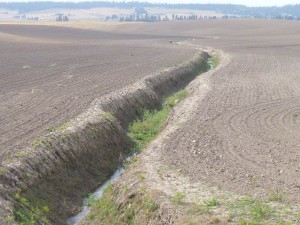Streamside, or riparian, vegetation performs vital ecosystem functions for our waters. To name a few, it keeps the water cool in the summer, filters pollutants, provides habitat, and contributes woody debris. Portions of the Little Spokane River, like this one behind St. Georges School have great riparian habitat. Healthy riparian habitat consists of a combination of tall mature trees, willows, and aquatic plants.

However, portions of Deadman Creek, a tributary of the Little Spokane River shown below, need major improvements.
A small riparian buffer, like the one shown below, filters out sediments, nutrients, toxins, and bacteria.
Our native redband trout and other species that depend on our waters need intact riparian habitat. For one, redband trout need cool waters of less than 20°C (68°F), which are kept cool from overhanging riparian trees and shrubs.


